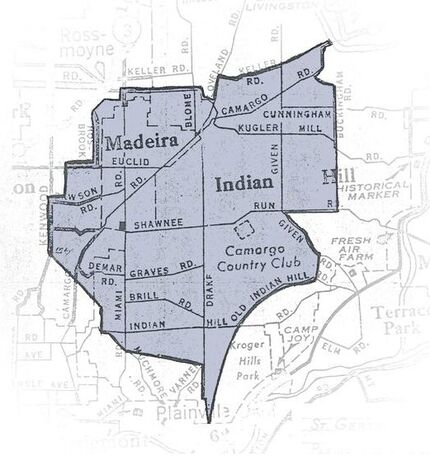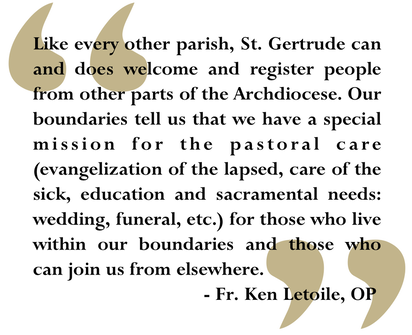Why does St. Gertrude Parish exist?
St. Gertrude Parish exists for our parishioners and for all who live within our boundaries, that they might personally know the love of God in Jesus Christ.
This isn't terribly unique. In fact, it is the purpose of every parish:
St. Gertrude Parish is our part of “the whole world,” it’s our “ends of the earth.” Most people might not know this but, according to the Catholic Church, a parish “is to be territorial” (Can 515 §1); it is “a certain community of the Christian faithful stably constituted in a particular church, whose pastoral care is entrusted to a pastor” (Can 518). A parish is a geographical area, a region within which the pastor “is obliged to make provision so that the word of God is proclaimed in its entirety to those living in the parish . . . He is to make every effort, even with the collaboration of the Christian faithful, so that the message of the Gospel comes also to those who have ceased the practice of their religion or do not profess the truth faith” (Can 528 §1). It is incumbent on the pastor, with the collaboration of the lay faithful, that the Gospel be proclaimed within the parish.
The word "parish" is worth reflecting on for a moment. The origins of the word are Greek. Here’s how it breaks down: para means “near” and oikos means “house.” So, a parish literally has to do with houses that are near one another—a neighborhood. In Latin, the word would come to refer to “sojourners.” Here, we add in this element of those who are on a journey. The result is rather beautiful. A parish refers to pilgrims who are sojourning near each other on their journeys to a heavenly homeland.
Our parish origins span back to 1923, when St. Gertrude Church was established as a mission church in the Madeira area. We were officially established as a parish (consisting of large swathes of Indian Hill and Madeira) within the Archdiocese of Cincinnati in 1944. This is our mission territory, and our vision is that those living within the parish would be given opportunities to encounter Jesus Christ.
This isn't terribly unique. In fact, it is the purpose of every parish:
- In Matthew’s Gospel, Jesus commissions his followers to “Go . . . and make disciples of all nations, baptizing them in the name of the Father, and of the Son, and of the Holy Spirit, teaching them to observe all that I have commanded you” (Mt 28:19–20).
- In Mark’s Gospel, Jesus says, “Go into the whole world and proclaim the gospel to every creature” (Mk 16:15).
- Acts of the Apostles contains a similar message: “You will receive power when the Holy Spirit comes upon you, and you will be my witnesses in Jerusalem, throughout Judea and Samaria, and to the ends of the earth” (Acts 1:6).
St. Gertrude Parish is our part of “the whole world,” it’s our “ends of the earth.” Most people might not know this but, according to the Catholic Church, a parish “is to be territorial” (Can 515 §1); it is “a certain community of the Christian faithful stably constituted in a particular church, whose pastoral care is entrusted to a pastor” (Can 518). A parish is a geographical area, a region within which the pastor “is obliged to make provision so that the word of God is proclaimed in its entirety to those living in the parish . . . He is to make every effort, even with the collaboration of the Christian faithful, so that the message of the Gospel comes also to those who have ceased the practice of their religion or do not profess the truth faith” (Can 528 §1). It is incumbent on the pastor, with the collaboration of the lay faithful, that the Gospel be proclaimed within the parish.
The word "parish" is worth reflecting on for a moment. The origins of the word are Greek. Here’s how it breaks down: para means “near” and oikos means “house.” So, a parish literally has to do with houses that are near one another—a neighborhood. In Latin, the word would come to refer to “sojourners.” Here, we add in this element of those who are on a journey. The result is rather beautiful. A parish refers to pilgrims who are sojourning near each other on their journeys to a heavenly homeland.
Our parish origins span back to 1923, when St. Gertrude Church was established as a mission church in the Madeira area. We were officially established as a parish (consisting of large swathes of Indian Hill and Madeira) within the Archdiocese of Cincinnati in 1944. This is our mission territory, and our vision is that those living within the parish would be given opportunities to encounter Jesus Christ.
Our Parish Boundaries
|
Northern: From the intersection of Miami and Kugler Mill Road (East Galbraith), east and then southeast along Kugler Mill Road to its intersection with Loveland-Madeira at the B&O SW R.R. north on Loveland-Madeira to the junction of Keller Road with it, west on Keller to its junction with Camargo Road, approximately at the Little Miami River.
Western: From the junction of Sunshine Road with Indian Hill Road, north along Sunshine Road approximately 2,650 feet to its end, then by air line northwest to the junction of Cherokee Road with Kenwood Road, then north on Kenwood to the junction of Dawson Road with it, east on Dawson to its junction with Eleck Place, north on Eleck Place, north to Euclid, east on Euclid to the junction of Hosbrook with it, then north on Hosbrook to a point due west of the junction of Meyer Road and Miami Avenue, which is also where the Madeira County Line leaves Miami Avenue and goes west about 250 feet, then east by air line from this point to the junction of Meyer Road and Miami, then north on Miami to its intersection with Kugler Mill (East Galbraith) Road. |
|
Eastern: From the point where Camargo crosses the Little Miami River, southwest along said road to the junction of Buckingham extended west with it, east and then south along Buckingham to its junction with Kugler Mill, then by air line due south to Shawnee Run, then west on said road to its intersection with Given Road, then southeast on Given to the junction of Newtown Road with it, then by air line due south to a sharp right turn in Old-Indian Hill Road.
Southern: From the above point on Old Indian Hill, then southwest along said road to its junction with Indian Hill Road, then by air line running southwest to the end of Drake, which is approximately 3,500 feet due north of the Little Miami River, then north along Drake to the junction of Varner Road with it, then by air line northwest to the junction of Muchmore Road with Miami, then by air line from this point to the junction of Burley Hills with Indian Hill Road to the junction of Sunshine Road with it. |





